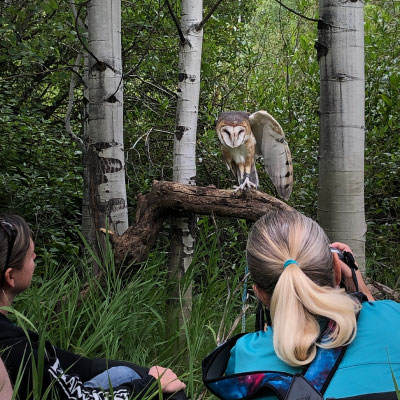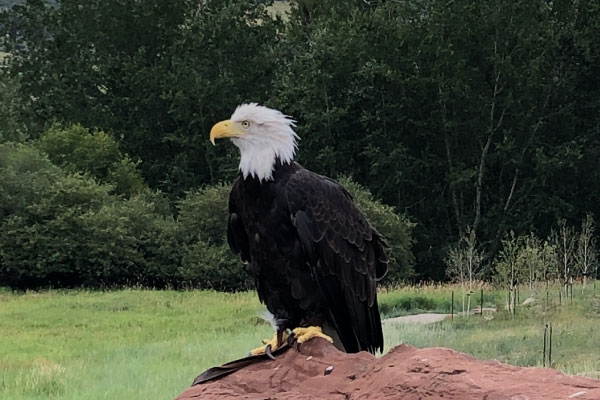
If you could pick any super power, what would you choose? It is fun to watch superhero movies and imagine what we might do if we could fly, have super strength, or an incredible sense of hearing. Although these movies are imaginary, there are some real species of raptors with such incredible senses, you might just call them super powers. Let’s meet four of these birds whose super senses standout among Eagle County’s wildlife.
Raptors are a group of birds defined by their hooked beaks, strong talons, and ability to capture prey. The following species have all the above characteristics AND additional super adaptations that help them to thrive.
 An owl’s greatest superpower is its stealth. The great horned owl is a regular resident of Eagle County, and the most widespread owl species in North America. It has fringed feathers which help it to fly silently in order to hear the movements of unsuspecting prey. The great horned owl also possess exceptional night vision, helping it to hunt in the dead of the night. They are regularly able to capture and carry prey two to three times larger than themselves. Their strength, coupled with their poor sense of smell, helps them to be one of the few species that regularly preys on skunks.
An owl’s greatest superpower is its stealth. The great horned owl is a regular resident of Eagle County, and the most widespread owl species in North America. It has fringed feathers which help it to fly silently in order to hear the movements of unsuspecting prey. The great horned owl also possess exceptional night vision, helping it to hunt in the dead of the night. They are regularly able to capture and carry prey two to three times larger than themselves. Their strength, coupled with their poor sense of smell, helps them to be one of the few species that regularly preys on skunks.
It is rare to spot a northern goshawk in the Eagle Valley, but they can be found amidst thick pine, spruce, and aspen forests. The goshawk is a brown and white bird in the hawk family that uses its broad wings and thick tail like a rudder to maneuver amongst the trees. While most raptors prefer to hunt out in the open, the goshawk’s agility helps it to hunt in thick trees. This raptor is a fierce predator and has been known to chase prey into water to catch, and may even attack other hawks and owls when they get too close.
Vultures are more closely related to storks than other raptors, but they are still considered birds of prey. Although they get a bad rap for eating carrion, they are an incredibly important part of nature’s clean-up crew. The only species of vulture that can be found in Eagle County is the turkey vulture, which can be spotted by its redhead and dark wings with a light underside, soaring with its wings in an iconic “V” shape. While most birds have a poor sense of smell, the turkey vulture can sniff out a carcass from miles away. They also have the incredible ability to poop on their own feet to stay cool, and vomit up the contents of their stomach when threatened. Those are a few superpowers I am not sure I would want to have.
You can’t talk about super birds without mentioning the peregrine falcon. Superman has nothing on the peregrine falcon, which has been clocked diving at speeds of up to 240 miles per hour. Falcons can also maintain average flying speeds of 24-33 miles per hour. Falcons prefer to dive bomb their prey, often dropping from heights of up to 3,000 feet above the unsuspecting goose or pigeon. Sometimes, just the impact of their talons is enough to kill or stun their prey.
 If you would like to learn more about the incredible abilities of raptors, Walking Mountains Science Center will be hosting Nature’s Educators on Friday, August 13. Come meet a variety of live raptors, and learn about these special birds. This program is free, and designed for families of all ages.
If you would like to learn more about the incredible abilities of raptors, Walking Mountains Science Center will be hosting Nature’s Educators on Friday, August 13. Come meet a variety of live raptors, and learn about these special birds. This program is free, and designed for families of all ages.
If you go…
What: Talon Talk with live raptors!
When: Friday, August 13 2021 from 1 p.m. to 2 p.m.
Where: Walking Mountains Science Center in Avon
Cost: Free, to celebrate the 10th anniversary of our Tang Avon Campus!
Please register here: www.walkingmountains.org
Resources:
https://www.allaboutbirds.org/guide/Northern_Goshawk/lifehistory
https://www.nationalgeographic.com/animals/birds/facts/great-horned-owl
https://www.allaboutbirds.org/guide/Peregrine_Falcon/lifehistory
Field Guide to Birds Western Region by: Donald and Lillian Stokes
Rocky Mountain Birds by Garrick Pfaffmann
Rachel Dorencz is the Community Programs Coordinator specializing in early childhood environmental education. She spends her free time keeping her pet rabbit, Bunbun, far away from hungry raptors.









